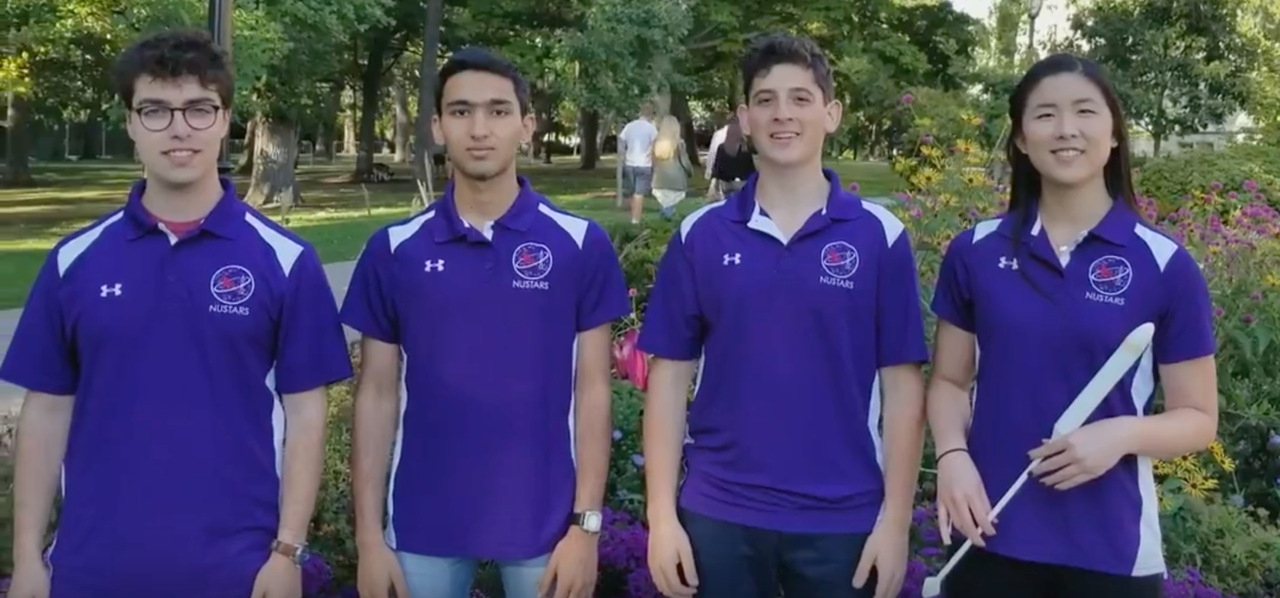
Cindy (right) and the rest of the Big 10 competition winning team.
Photo courtesy of Cindy Chen
Coming into college, rocket science was not something that McCormick junior Cindy Chen had thought about. “I walked past it at an activity fair freshman year, and I thought, ‘Rockets are cool, I guess.’ And then I sold my soul to rocketry.”
Just two years later, Chen has recently worked with the Boeing Space Center on the SLS, the Space Launch System that will be NASA’s Mars rocket. For Chen, “it’s really satisfying when you actually get to go to launch and fix the millions of problems that inevitably come up, and that’s after problem-solving on the fly.”
Chen is a member of NUSTARS, Northwestern University Space Technology and Rocketry Society, which is comprised of two rocketry teams – the NASA Student Launch Initiative (NSL) and Foundation – a balloon team, a research team and an educational outreach platform. Within NUSTARS, Chen is a payload mechanical lead for NSL and was a part of both rocketry teams last year.
Every year, rocketry teams are given challenges with real-world applications for competitions. This year’s NSL project is a rover, which essentially mimics NASA's Mars Rover Project.
Chen is also a part of a special Big 10 competition involving Alka-Seltzer rockets. The task is to launch a rocket as high as possible using up to 100 Alka-Seltzer tablets as propellant.
Along with juniors Noah Sims and Joshua Werblin and sophomore Manan Shah, Chen will be going to NASA’s Johnson Space Center in Houston, Texas as finalists in the competition. The winners will receive $25,000 as well as the Guinness World Record for the highest altitude achieved by an Alka-Seltzer rocket.
Using the 100 Alka-Seltzer tablets, the team is expecting an altitude of 600 to 700 feet. So far, only a proof-of-concept of the propulsion has been completed, but after redesigning and rebuilding the rocket, the team hopes to perform a test launch before traveling to Texas.
The Alka-Seltzer competition has presented many challenges for the team.
“This is a novel experience in general because normally the propellant we deal with is like solid-core motors that are made from different types of metals that combust and actually make fire and give us gas," Chen said. "But in this case the only propellant we get to use is water and Alka-seltzer, which gives us the carbon dioxide. It’s a problem that we’ve never seen before."
Time was another hurdle to the NU Stars, as other schools within the Big 10 were able to begin work on their projects well in advance relative to Northwestern due to the quarter system. NU Stars had essentially two weeks at the beginning of the quarter to design and build their rocket, which includes a propulsion/launch system.
Rocket science is grueling. As Chen puts it, “nothing ever goes the way you want it to.” The team experienced problems with manufacturing the launch vehicle since it was a design that is not often seen in rocketry. The team also had to ensure that the compressed gas would go in the proper direction and not escape the chamber while held at 600 to 700 psi. For comparison, a lion has a bite force of 1,000 psi, which means that the chamber must contain pressure approaching that of a lion’s bite.
These problems are difficult to overcome, and with the limited time available to the team, it is all the more impressive that they are now one launch away from the record books and one giant leap for rocket science.